Beware the sheep. Posted by hulda on Jun 27, 2012 in Icelandic culture, Icelandic customs
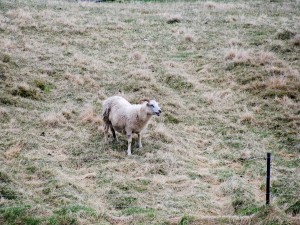 For those who only see Reykjavík during their stay in Iceland they probably only show up on a menu on every restaurant you go to, but once outside the city they’ll become a regular feature. On hills, mountains, meadows, they’re everywhere. Even in places where you’d think no animal or even human could venture unless it were for falling in, sauðfé, the sheep will be there. As my future mother-in-law would say when she’s referring to their ability to climb: “Icelandic sheep are part goat” (although I’m sure the local sheep might actually leave the goats behind).
For those who only see Reykjavík during their stay in Iceland they probably only show up on a menu on every restaurant you go to, but once outside the city they’ll become a regular feature. On hills, mountains, meadows, they’re everywhere. Even in places where you’d think no animal or even human could venture unless it were for falling in, sauðfé, the sheep will be there. As my future mother-in-law would say when she’s referring to their ability to climb: “Icelandic sheep are part goat” (although I’m sure the local sheep might actually leave the goats behind).
The Icelandic sheep is one of the oldest breeds in the world, first introduced by the settlers during the viking age. They have stayed almost unchanged throughout the history due to their isolated location. They come in many types and colours, yet they all share the qualities of producing a good amount of milk, having very tasty meat (Icelandic sheep are said to be among the best in the world in this regard) and having unusually good quality wool. Sheep everywhere have been bred mostly for wool and the different types of it suit different climates, but in Iceland you really want your lopapeysa, wool sweater, to be made out of the Icelandic type.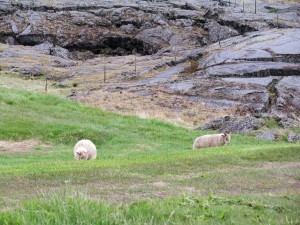
The Icelandic wool is of the extremely curly variant, making it easy to felt. This makes for an almost wind- and waterproof knit, and once you’ve been here you’ll quickly see why this is very important. I have never needed a raincoat other than my sweater and as for umbrellas – forget about them, they’re no use when the rain comes at you horizontally. Which it does. You think you have an idea of what I’m talking about but before you’ve tried the local storms you really don’t. As a side note: the locals call storms a drizzle. If they’re actually talking about óveður (= storm) you ought to beware low-flying trucks.
One of the key reasons to why these sheep are superior lies in the way they’re herded. They’re let to roam free throughout the summer and only gathered back in the autumn in a huge working “festival” called réttir (= round-up). If you’re around that time of the year you can even partake in it, the farmers often welcome extra help! For anyone who knows how reindeer are herded the system is very similar. Most of the year the sheep roam free and they are often close to being wild animals, they do not trust humans unless they’re for one reason or another in regular contact with them. In a réttir they’re all collected from the mountains into a huge pen that you can see in the middle of the photo above, and then caught one by one and sorted to the outer segments according to whose mark is on them.
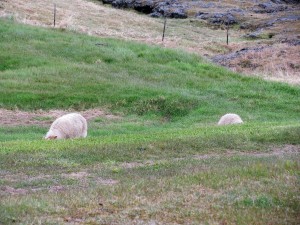 However, this type of herding has its downsides, mainly because the sheep often graze near the roads. For most of the countryside there are no fences to stop them and even if there are some they hardly stop the sheep from finding a way through them. They often get too used to cars driving by, they may even be walking on the road ahead of you. When you’re driving and see a sheep you should immediately slow down. Sheep are unpredictable in what they’ll suddenly decide to consider dangerous and they are very likely to first run to one direction – away from the road – and then do a last minute turn back right in front of your car. Another fact is that if the lamb is on the other side of the road to the ewe it will run across the road just as you’re almost passing them. Be prepared for anything and everything.
However, this type of herding has its downsides, mainly because the sheep often graze near the roads. For most of the countryside there are no fences to stop them and even if there are some they hardly stop the sheep from finding a way through them. They often get too used to cars driving by, they may even be walking on the road ahead of you. When you’re driving and see a sheep you should immediately slow down. Sheep are unpredictable in what they’ll suddenly decide to consider dangerous and they are very likely to first run to one direction – away from the road – and then do a last minute turn back right in front of your car. Another fact is that if the lamb is on the other side of the road to the ewe it will run across the road just as you’re almost passing them. Be prepared for anything and everything.
If, despite your best efforts, you still end up hitting a sheep with your car the only thing you can do is to try to find out whose sheep it is, contact the farmer and pay for it. This can be tricky since there can be many farmers sharing the same grazing grounds so potentially it can mean a lot of frustrating driving around, but it’s still better than to try to run away. Iceland is a tiny country, foreigners are still interesting enough to warrant attention and the locals know what a car looks like after it has hit a sheep. This combination makes it rather easy for a hit and run culprit to be found and paying for the sheep straight to its owner comes a lot cheaper than paying via the law.
There are other downsides as well but thankfully they’re much easier to deal with. The sheep do get everywhere like mentioned, even – and especially – on camping sites. I’ll never forget that one night we tried to sleep near Mývatn (= Midge Lake, be warned that this name is very accurate for the lake area) when a lamb got lost from its mother behind our tent. Meanwhile the ewe was standing in front of the tent and was trying to call out to it, to which the lamb naturally always replied to but somehow the two just couldn’t figure out where the other one was. After a nearly half an hour of “BRAAAAHH” – “meeeeh!” – “BRAAAAHH” – “meeeeh!” – “BRAAAAHH” I finally got so fed up with them I crawled out of the tent and chased them away. I do hope they eventually found each other but their general level of intelligence considered I cannot say I’m 100% certain of it…

Build vocabulary, practice pronunciation, and more with Transparent Language Online. Available anytime, anywhere, on any device.
About the Author: hulda
Hi, I'm Hulda, originally Finnish but now living in the suburbs of Reykjavík. I'm here to help you in any way I can if you're considering learning Icelandic. Nice to meet you!



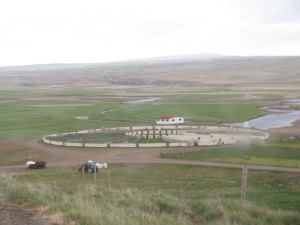
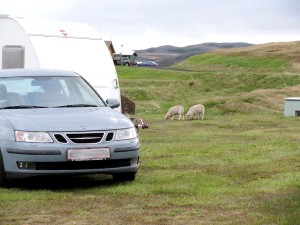

Comments:
Helen:
This article almost made me feel at home. If you’ve been to Yorkshire (where I come from), you know you have to watch out for sheep when driving there up on the moors. I’ve also seen this in Ireland and Scotland. I once helped pull a sheep out of a bog while hiking in Scotland, needless to say the farmer was very pleased and allowed us to camp on his land for free. I’ve seen films of the “réttir”, it looks quite an experience if you have the energy!